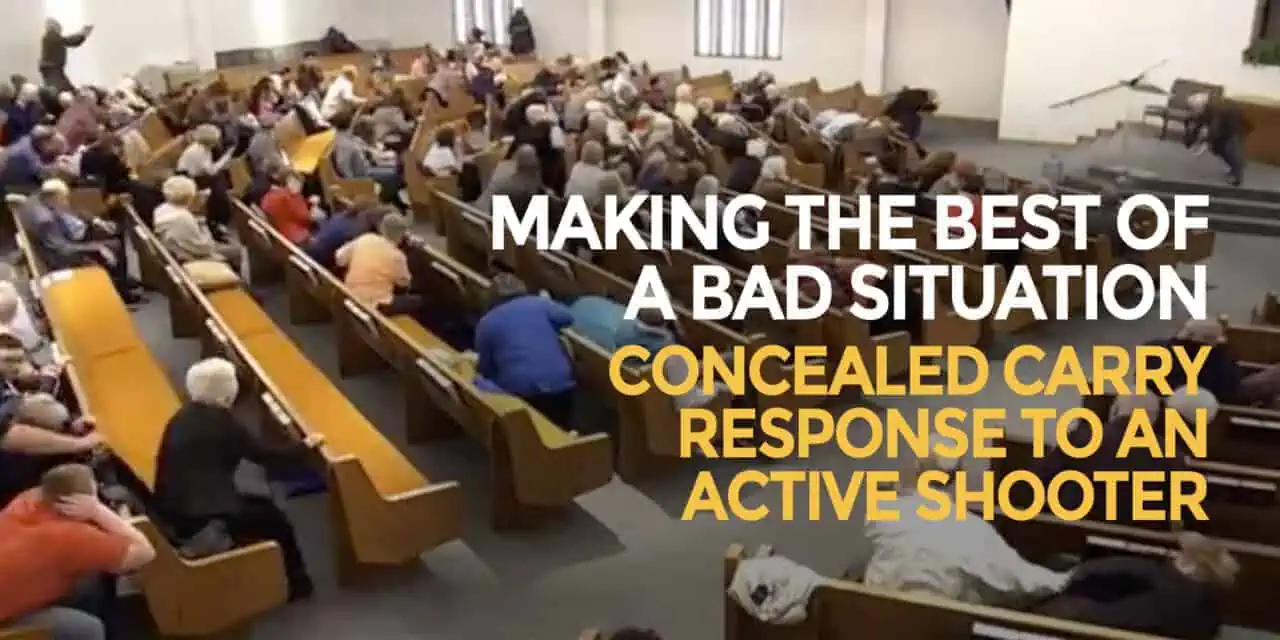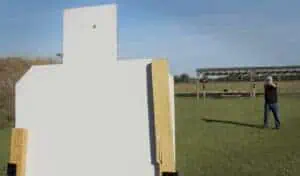Surviving An Active Shooter Event
On the morning of December 29, 2019, a man entered the West Freeway Church of Christ in White Settlement, Texas. He hid a pistol-grip shotgun under his clothes and had evil on his mind. As the church service progressed, he got up from his seat, approached one of the ushers, and pointed his shotgun at him. Another churchgoer, who was a member of the church’s security team, started to draw a pistol, catching the gunman’s eye. The gunman turned to that second man, pointed his shotgun, and fired it. He then shot the usher in front of him and started to make his way to the front of the church. Another church member drew his pistol and stopped the gunman with one shot from approximately 12 yards away.
This extraordinary event was recorded in its entirety on the church’s live video feed. This presents us with a unique opportunity to learn what may or may not work in a lethal force encounter. Let’s see what lessons responsibly armed citizens can learn about surviving an active shooter event.
A Tale Of Two Citizens
To begin with, let’s take a look at the video from the church and break down what happened. This video is not for the faint-hearted, so beware. This is a real-world encounter with real-world results. If you’re squeamish, at work, or if there are kids in the room, you may not want to watch it.
The perpetrator shot Richard White first. White was armed at church that day. He saw the attacker raise a gun, but was unable to get an effective shot off before his life was taken from him. This is a tragic loss, but there are lessons to be learned in tragedy.
Hard Lessons Learned The Hard Way
For those who carry concealed, some of the best methods for surviving an active shooter event may not involve a firearm. If we see trouble before it happens and take preventative action, then we solve the problem before it happens. Having more than one kind of response available to you is always a good idea. So is learning how to diffuse a situation with words, not actions.
Knowing when to use a gun versus another method of attack is also very important. The attacker approached an usher first and appeared to start a conversation with him. At that point, had Mr. White closed the distance and joined in the conversation, it would have placed both of them in an excellent position to overpower the attacker as the gun came out. Could the two men have physically stopped the perpetrator before he had the long gun out from behind his jacket?
The bottom line is, if someone looks like trouble, they probably are. Act accordingly.
Response Time
It took four and a half seconds for the attacker to get his shotgun out from under his clothing and fire his first shot. This is more than enough time for most people to get off at least one shot from concealment. In this case, however, it wasn’t enough for Mr. White.
I suspect the reason for this is how Mr. White was carrying his gun. It appears from the video that he was either carrying his pistol far back on his waistline (“4 o’clock”) or in a holster on the small of his back. Carrying in this position means your hand is going to have to travel further to reach your gun. It also means your gun has further to travel before it can get on target. Carrying in a more accessible position, either closer to the side on the waist or appendix carry, could result in a faster draw.
Mr. White saw a gun and he responded with a gun. We do not know his training history, but I suspect it was long on firearms training and short on hand-to-hand work or grappling. This is not uncommon in the firearms community. We tend to see the gun as the be-all and end-all of self-defense. We forget that there is more to keeping yourself safe than just pulling a trigger.
Now let’s look at how Jack Wilson, another member of the church security team, responded to the threat that unfolded right in front of him.
Making the Shot When It Counts
Jack Wilson faced a different sort of challenge. He saw two fellow church-goers fall to gunshots, so he knew the gunman was willing to kill. He was farther away and had a number of innocent bystanders between him and the gunman.
Despite all this, he stepped up and made one of the best, if not the best, responses to an active shooter event we’ve seen caught on video. A 15-yard headshot in under three seconds is a standard that, quite frankly, very few gun owners can achieve.
Surviving An Active Shooter Event Means Making The Best of a Bad Situation
Let’s talk about some of the takeaways from this video for those of us who carry concealed on a regular basis.
Identify the Threat
First, the earlier you identify trouble as trouble, the more options you have to deal with it.
The attacker was known to be a problem, and church members were keeping an eye on him in case something happened. A smiling, friendly, heavily armed member of the church security team sitting next to him in the pew may have prevented a tragedy. Sadly, we’ll never know in this case. But in general, if it looks like trouble, it probably is. Plan accordingly.
Training Is Key
Secondly, it’s going to be harder than you think. If you’re not pushing yourself to the point of failure with your training, then you’re not training, you’re just playing around with guns. I understand that shooting guns is fun, but there is stuff we do for fun and stuff we do to get better at defending our lives. If you don’t know your baseline limits or haven’t trained with a timer, do so now.
Thirdly, surviving an active shooter event means using what you have on you at that moment, with the skills you can instantly use. Both of these men had to deal with a direct, imminent threat to their lives with what they had with them at that moment. They didn’t get a chance to get in a fifty-round practice drill first. They weren’t able to run out to their cars in the parking lot and grab more firepower. Life isn’t a video game. There won’t be a moment where we can up-gun, add more armor, or add experience points to develop new skills before we have to tackle the boss. The boss shows up whether we’re ready for it or not.
When you go to the range for fun, relax and enjoy the time spent with your friends or family. When you go to the range to train, train like your life depends on it. Because it just might.




Timer? You can’t miss fast enough. ACCURACY is the goal, not speed.
I bet Richard White’s family wishes that he, or Jack Wilson, could have gotten their guns out a couple of seconds sooner – the less time you waste while drawing, the more time you can use aiming and shooting…
One thing not mentioned is that the first guy stood up, telegraphing himself before and while drawing his gun slowly against someone who already had a shotgun in hand, at the ready. No way to win that one. He would have been much better off to remain seated and draw or to take cover behind the pew and draw, thereby not bringing the shooter’s attention upon himself.